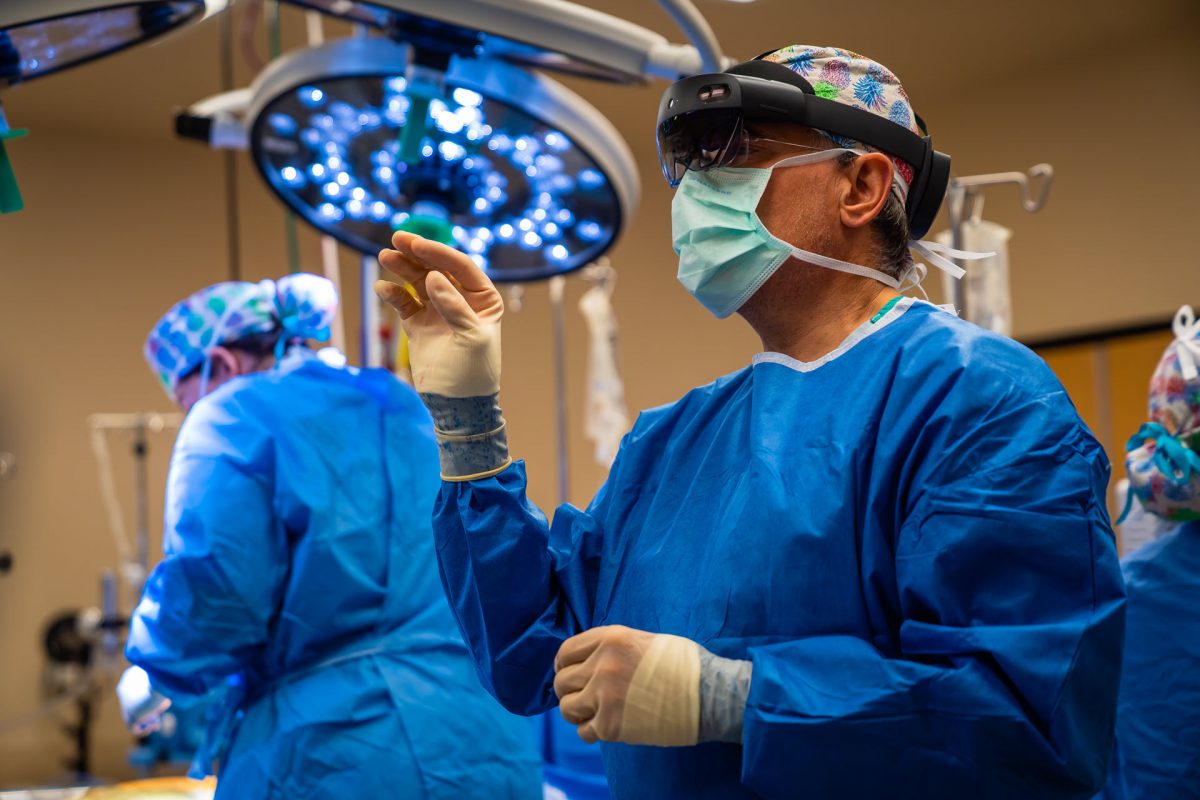One of the most important industries of our time is the healthcare industry. At some point, everyone gets sick, and in these moments, we rely on our healthcare professionals to make the right decisions and help us in the best possible way.
With the entire world evolving and innovative technologies disrupting different industries, the healthcare industry has also made great advances. Especially, the application of augmented reality (AR) and virtual reality (VR) pose as one of the most promising progresses in training of medical staff for surgeries (Hastings, 2022).
Augmented Reality glasses enhance the vision field of the user with additional information (Hastings, 2022). There are already multiple use cases of AR glasses deployed by medical professionals when performing surgical procedures, especially in the orthopedic area (Chytas, Malahias & Nikolaou, 2022).
One of the use cases was in 2020, performed by orthopedic surgeon, Dr. Abraham del Real. Using the HoloLens, he saw an overlay of scans of the patient and models on the surgical field during the procedure (Accenture, 2020). Having important information of the patient before the eyes, the surgeon can fully focus on the surgery while the handsfree technology provides the surgeon with real-time and critical data, such as patient anatomy and scans (Hastings, 2022). AR can also be utilized for educational purposes in healthcare. For instance, inexperienced medical professionals can use AR to learn from more senior professionals. Experienced surgeons can remotely supervise surgeries without being physically in the room (XRtoday, 2022).
Aside from utilizing AR technology in healthcare, VR technologies are also used for surgeries and educational purposes. Whereas AR for example enhances the field of the surgeon, VR can create an entire virtual operating room (McCallum, 2022). Last months, a surgeon from Latin America separated a set of conjoined twins with the help VR (McCallum, 2022). By utilising VR technologies, a team of specialists, located in different countries, experimented with different techniques and approaches using VR projections based on CT and MRI scans of the twins. They operated in the same virtual room and therefore gained experience and useful insights before the actual surgery. This way, the risks and complications during the surgery were reduced (McCallum, 2022) because the doctors were already familiar with the planned procedure.
The collaboration between surgeon and AR or VR are already under their way. If one day you were in need of surgery, would you want your doctor to integrate these technologies in your surgery?
References
Conn Hastings, 2022 ‘AR Headset Helps Surgeons Place Implants: Interview with Louie Vogt of Enovis Surgical | Medgadget, 18 August. Available at: https://www.medgadget.com/2022/08/ar-headset-helps-surgeons-place-implants-interview-with-louie-vogt-of-enovis-surgical.html (Accessed: 16 September 2022).
Augmented Reality (AR) for Surgical Success Case Study | Accenture (2020). Available at: https://www.accenture.com/ae-en/case-studies/technology/microsoft-hololens-surgery (Accessed: 20 September 2022).
Shiona McCallum 2022, ‘Conjoined twins separated with the help of virtual reality’, | BBC News, 1 August. Available at: https://www.bbc.com/news/technology-62378452 (Accessed: 16 September 2022).
Chytas, D., Malahias, M.-A. and Nikolaou, V.S. (2019) ‘Augmented Reality in Orthopedics: Current State and Future Directions’, Frontiers in Surgery, 6, p. 38. Available at: https://doi.org/10.3389/fsurg.2019.00038.
How Is AR Transforming the Healthcare Industry? (2022) XR Today, 1 March. Available at: https://www.xrtoday.com/augmented-reality/how-is-ar-transforming-the-healthcare-industry/ (Accessed: 20 September 2022).
‘Is the healthcare industry spearheading the metaverse?’ (2022) Verdict, 25 August. Available at: https://www.verdict.co.uk/is-the-healthcare-industry-spearheading-the-metaverse/ (Accessed: 16 September 2022).


Great blog with an extensive use of scientific sources! This blog sketches a bright, positive future for chatbots in healthcare. However, I think that the downsides of AI-based robots could be assessed more in-depth to give a complete image of the development. As you said, privacy and responsibility are two challenges, but in the future we also have to think about ethical issues. For example, are we fine with the idea of elderly being supported by functional or chat robots, which leads to less human interaction?
I’m sorry, I commented on the wrong article. I wrote the comment above for the article “Oh my god, my doctor is a robot!”.